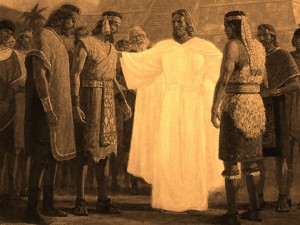Here’s the introduction to this series, and here is the previous entry.
Book of Mormon quotes here, as for the entire series, is taken from The Book of Mormon: The Earliest Text (Royal Skousen, ed.).
This is the first (though far from the last) time that Orson Pratt’s chapter division matches that found in the 1830 first edition of the Book of Mormon (and, as explained in the first post, apparent chapter divisions indicated as Joseph dictated the contents of the Book of Mormon). This is also quite a bit shorter than Nephi’s first three chapters, which suggest that there may be thematic reasons this chapter stands alone.
Nephi Starts His Ministry
Nephi has at the start of his first three chapters referred either explicitly or implicitly to his “ministry”. His own subtitle for this book, found in the introduction just before Chapter I, is “His reign and ministry”. At the start of Chapter II (1 Nephi 6), Nephi states that “the fullness of mine intent is that I may persuade men to come unto the God of Abraham and the God of Isaac and the God of Jacob and be saved.” And at the start of Chapter III (1 Nephi 10), he writes “And now I Nephi proceed to give an account on these plates of my proceedings and my reign and ministry” — but then goes own largely to describe his father’s prophesies of the Messiah and his own ascension vision.
With that vision, Nephi now appears confident in instructing his brothers in a prophetic manner — not just bearing testimony or asking why they don’t listen to Lehi, but offering his own prophetic interpretations and directions. In fact, that’s what the entire chapter is about: Nephi explaining not just Lehi’s vision and prophecies, but his own vision and prophecies as well, as well as his interpretations of the scriptures. He is ministering in a prophetic fashion to his brothers, and they (by his account) accept that prophetic ministry, however briefly. As Nephi notes near the start of this chapter:
And it came to pass that I beheld my brethren,
and they were disputing one with another
concerning the things which my father had spoken unto them.
For he truly spake many great things unto them
which was hard to be understood
save a man should inquire of the Lord.
And they being hard in their hearts,
therefore they did not look unto the Lord as they had ought.
Nephi steps in, asks what they are arguing about, asks if they have “inquired of the Lord”, rebukes them for “the hardness of [their] hearts”, and then proceeds to explain Lehi’s vision and prophecies to them. He notes that he has success where his father did not:
And it came to pass that I did speak so many words unto my brethren
that they were pacified and did humble themselves before the Lord.
He also urges them to personal obedience and righteousness:
Wherefore I Nephi did exhort them to give heed unto the word of the Lord.
Yea, I did exhort them with all the energies of my soul
and with all the faculty which I possessed
that they would give heed to the word of God
and remember to keep his commandments always in all things.
Now his brothers start asking more questions, not just interpreting Lehi’s vision but expounding on details that Lehi missed:
And they said unto me:
What meaneth the river of water which our father saw?
And I said unto them that the water which my father saw was filthiness.
And so much was his mind swallowed up in other things
that he beheld not the filthiness of the water.
This continues on for a while; then Nephi wraps up with a Q&A session that presages Alma2‘s discourse to his son Corianton about the afterlife, judgment, and eternity, tying at the end of the chapter the whole discussion back to his and his father’s visions:
Wherefore the wicked are separated from the righteous
and also from that tree of life
whose fruit is most precious and most desirable of all other fruits;
yea, and it is the greatest of all the gifts of God.
And thus I spake unto my brethren.
Amen.
Through these first four chapters of the Book of Nephi, Nephi has been tracing his own arc. He starts as the youngest (and therefore least important) of four sons, one who cries unto the Lord to have his own heart softened so that he does not “rebel against” his father Lehi. He now stands as a prophet who has great visions and who — with temporary success — calls his older brothers to repentance and from whom his brothers seek spiritual and scriptural explanations. Keep in mind that Nephi is writing all this some 30+ years later, after arriving in the promised land, and after the great family split — that is, Nephi and those who would follow them fleeing for their lives from Laman and Lemuel. He writes these chapters, I believe, to bear testimony to the descendants of Laman and Lemuel as to how things really were.
Next post: First Nephi V (1 Nephi 16 – 19:21).
